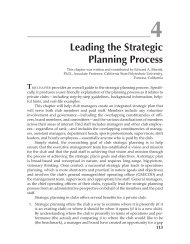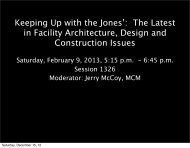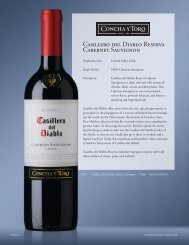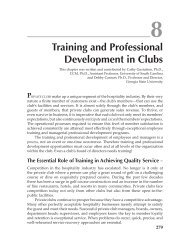The Board of Directors and the General Manager/Chief Operating ...
The Board of Directors and the General Manager/Chief Operating ...
The Board of Directors and the General Manager/Chief Operating ...
You also want an ePaper? Increase the reach of your titles
YUMPU automatically turns print PDFs into web optimized ePapers that Google loves.
Exhibit 8<strong>The</strong> <strong>Board</strong> <strong>of</strong> <strong>Directors</strong> <strong>and</strong> <strong>the</strong> <strong>General</strong> <strong>Manager</strong>/<strong>Chief</strong> <strong>Operating</strong> Officer 57Checklist for Preparing a <strong>Board</strong> Meeting AgendaWhen preparing a written agenda for a board meeting, a club general managershould check to be sure that:• <strong>The</strong> agenda contains a clear indication <strong>of</strong> why <strong>the</strong> meeting is being called.• <strong>The</strong> agenda is sent out in advance to everyone expected at <strong>the</strong> meeting.• Relevant supplementary material is attached (reports, statistical information,proposals).• Time is reserved for announcements.• It says who is running <strong>the</strong> meeting.• Time is reserved for breaks during long or unusually difficult meetings.• Time is budgeted for each agenda item.• <strong>The</strong>re is an explanatory line or two after each agenda item to set <strong>the</strong> tone <strong>of</strong> <strong>the</strong>discussion.• <strong>The</strong> agenda follows a consistent format for each meeting.• <strong>The</strong> agenda identifies <strong>the</strong> type <strong>of</strong> action that must be taken on a given agenda itemwhen necessary (a recommendation, an assignment, a decision, <strong>and</strong> so on).• <strong>The</strong> agenda clearly identifies <strong>the</strong> location, starting time, <strong>and</strong> ending time <strong>of</strong> <strong>the</strong>meeting.• <strong>The</strong> names <strong>of</strong> individuals making reports are clearly noted.• <strong>The</strong> agenda avoids technical terms that might not be understood by all boardmembers (or explains any technical terms used).• Guests making presentations are placed early on <strong>the</strong> agenda so that <strong>the</strong>y canleave when <strong>the</strong>ir presentations are complete.At many clubs, it is <strong>the</strong> general manager who puts board meeting agendastoge<strong>the</strong>r, subject to <strong>the</strong> approval <strong>of</strong> <strong>the</strong> board president. (Exhibit 8 contains tips<strong>of</strong>fered by club general managers for preparing a board meeting agenda.) Althoughputting an agenda toge<strong>the</strong>r every month can be time consuming, many generalmanagers welcome this responsibility because it gives <strong>the</strong>m a measure <strong>of</strong> controlover board meetings <strong>and</strong> helps <strong>the</strong>m keep board members focused on policy <strong>and</strong>governance issues <strong>and</strong> away from <strong>the</strong> temptation to manage <strong>the</strong> club.Many general managers recommend that board meeting agendas be asdetailed as possible. For example, instead <strong>of</strong> simply listing “Treasurer’s Report,”ideally an agenda should list something like <strong>the</strong> following:Treasurer’s Report—15 minutesFinancial Review. (See <strong>the</strong> attached statement.)Capital Requests. <strong>The</strong> grounds committee is requesting a supplemental airconditioner for <strong>the</strong> Kaiser Building.
58 Chapter 2Information Item. <strong>The</strong> accounting department has just completed a selfaudit.(See <strong>the</strong> attached report.)Delinquent Accounts. This month we have four delinquent accounts. (See<strong>the</strong> attached report.)Just putting down “Treasurer’s Report” is too vague. It doesn’t outline what <strong>the</strong>board members are expected to concentrate on, which tempts some board membersto w<strong>and</strong>er <strong>and</strong> unnecessarily prolong <strong>the</strong> meeting. If agendas indicate <strong>the</strong>expected length <strong>of</strong> <strong>the</strong> meeting with a starting <strong>and</strong> an ending time, board memberswill have an idea <strong>of</strong> how much time <strong>the</strong>y should devote to a given topic. Sometimesevery agenda item is given an estimated time, as with <strong>the</strong> example just given(“Treasurer’s Report—15 minutes”).Ano<strong>the</strong>r tip from club general managers: only list committees on <strong>the</strong> agendathat actually have something to report. (<strong>The</strong> general manager can check with committeechairpersons before putting <strong>the</strong> agenda toge<strong>the</strong>r.) Traditionally, <strong>the</strong> boardmeeting agendas at many clubs listed every club committee, month after month.With that format, all committee chairpersons felt <strong>the</strong>y had to give some sort <strong>of</strong>report, even if <strong>the</strong>y didn’t have anything to say, which put some <strong>of</strong> <strong>the</strong> chairpersonson <strong>the</strong> spot <strong>and</strong> slowed <strong>the</strong> meetings down.Determining in what order to place items can also present general managerswith a challenge. <strong>The</strong>re are many ways to arrange an agenda. In <strong>the</strong> past, boardmeeting agendas typically started with <strong>the</strong> approval <strong>of</strong> minutes, <strong>the</strong>n moved onto committee reports, old business, <strong>the</strong>n new business. Some club general managershave suggested a new agenda model that facilitates <strong>the</strong> flow <strong>of</strong> discussion<strong>and</strong> schedules difficult items for when board members are freshest. This “action”agenda model is structured like this:• Announcements (15 minutes or less). <strong>The</strong>se are quick items that require nodebate. Announcements could include everything on <strong>the</strong> consent agenda(an agenda listing everything that will be voted on without discussion). Byquickly dealing with <strong>the</strong>se items, <strong>the</strong> board meeting’s facilitator (typically <strong>the</strong>board president) helps board members start to focus <strong>the</strong>ir attention on boardmatters <strong>and</strong> away from <strong>the</strong>ir outside concerns.• Easily discussed items (15 minutes). <strong>The</strong>se are black <strong>and</strong> white issues that canbe addressed quickly. Dealing with <strong>the</strong>se items early in <strong>the</strong> meeting helps <strong>the</strong>board feel that progress is being made <strong>and</strong> can establish a sense <strong>of</strong> momentum<strong>and</strong> teamwork.• Most difficult item (25 to 40 minutes). This is <strong>the</strong> hardest or most controversialitem on <strong>the</strong> agenda. It’s usually something that needs a lot <strong>of</strong> discussion orrelates to a long-term need <strong>of</strong> <strong>the</strong> club. <strong>The</strong> facilitator should first state whatis expected <strong>of</strong> <strong>the</strong> members—discussion only or a decision. <strong>Board</strong> membersshould <strong>the</strong>n be given a chance to air <strong>the</strong>ir viewpoints.• Break (10 minutes). This is a chance for everyone to take a brea<strong>the</strong>r <strong>and</strong> think about<strong>the</strong> current discussion. It also allows for some behind-<strong>the</strong>-scenes persuasion or
<strong>The</strong> <strong>Board</strong> <strong>of</strong> <strong>Directors</strong> <strong>and</strong> <strong>the</strong> <strong>General</strong> <strong>Manager</strong>/<strong>Chief</strong> <strong>Operating</strong> Officer 59politicking. <strong>Board</strong> members might also take this time to smooth over any controversiesraised during <strong>the</strong> debate.• Most difficult item, continued (20 minutes). After <strong>the</strong> break, <strong>the</strong> discussion <strong>of</strong> <strong>the</strong>most difficult item is continued. Important points can be repeated <strong>and</strong> writtendown. If <strong>the</strong> board’s goal is to make a decision, <strong>the</strong> facilitator can call for a voteafter this discussion period.• Discussion-only items (30 to 40 minutes). This is <strong>the</strong> time to introduce new topicsor present committee <strong>and</strong> o<strong>the</strong>r reports. Placing committee reports near <strong>the</strong>end <strong>of</strong> <strong>the</strong> meeting, when people are getting eager to wrap things up, can helpkeep <strong>the</strong> reports short.• Least difficult items (10 minutes). <strong>The</strong>se items are ones that can be quickly votedon. Putting least difficult items at <strong>the</strong> end <strong>of</strong> <strong>the</strong> meeting can leave boardmembers with <strong>the</strong> feeling that <strong>the</strong>y can decide things efficiently <strong>and</strong> quickly.It ends <strong>the</strong> board meeting on a high note.Many general managers feel strongly that a board meeting’s agenda shouldbe mailed out to board members before <strong>the</strong> meeting. This gives board members achance to review <strong>the</strong> agenda <strong>and</strong> do any research <strong>the</strong>y feel is necessary. Mailing<strong>the</strong> agenda out ahead <strong>of</strong> time can save a lot <strong>of</strong> meeting time when <strong>the</strong> board getstoge<strong>the</strong>r. Clubs that follow this practice have discovered that <strong>the</strong>ir boards act morequickly <strong>and</strong> table fewer issues because board members arrive informed <strong>and</strong> readyto tackle <strong>the</strong> challenges <strong>the</strong>y face.<strong>The</strong> <strong>General</strong> <strong>Manager</strong>A club’s board governs <strong>the</strong> club, establishing policy; <strong>the</strong> club’s general managermanages it.Historically, most major management functions <strong>of</strong> a club were h<strong>and</strong>ledby committees who hired secretaries, stewards, or caretakers. <strong>The</strong>se positionsevolved into <strong>the</strong> first club manager positions. In most <strong>of</strong> <strong>the</strong>se positions, <strong>the</strong> firstmanagers had responsibility for only <strong>the</strong> clubhouse <strong>and</strong> food <strong>and</strong> beverage operations.Often <strong>the</strong> golf pr<strong>of</strong>essional <strong>and</strong> perhaps even <strong>the</strong> golf course superintendenthad as much or more administrative responsibility as <strong>the</strong> manager. All three <strong>of</strong><strong>the</strong>se positions (manager, golf pr<strong>of</strong>essional, <strong>and</strong> golf course superintendent) eachreported to <strong>the</strong> board <strong>of</strong> directors <strong>of</strong> <strong>the</strong> club or perhaps to individual committees.No one position had responsibility for overseeing all management responsibilities<strong>of</strong> <strong>the</strong> club operation. Conflict <strong>of</strong>ten developed <strong>and</strong> no clear lines <strong>of</strong> authority <strong>and</strong>responsibility existed.<strong>The</strong>n in 1927, <strong>the</strong> Club <strong>Manager</strong>s Association <strong>of</strong> America was formed byclub personnel who wanted information, education, resources, <strong>and</strong> a pr<strong>of</strong>essionalnetwork. At <strong>the</strong> time, training for <strong>the</strong> club manager was limited to a few hotel <strong>and</strong>food <strong>and</strong> beverage programs. CMAA developed a pr<strong>of</strong>essional development programto help managers become <strong>the</strong> leader <strong>of</strong> <strong>the</strong> entire club operation.In today’s club world, it usually takes formal education <strong>and</strong> some practicalexperience to attain even an entry-level management position. Today, one <strong>of</strong> <strong>the</strong>
60 Chapter 2Exhibit 9Getting Started at a Club<strong>The</strong> following list is certainly not exhaustive, but gives some examples <strong>of</strong> actionsa new general manager can take to get <strong>of</strong>f to a good start at a club:• Get to know your staff members as quickly as possible. It might be a good ideato have a private “get acquainted” meeting with each staff member.• Be visible. Circulate through <strong>the</strong> club each day for at least an hour, chatting informallywith club members <strong>and</strong> staff members.• Hold well-organized weekly staff meetings.• Communicate with your board. A weekly written status report might be a good idea.• Inspect <strong>the</strong> club each day.• Familiarize yourself with upcoming club events.• Learn about <strong>the</strong> club’s traditions.• Don’t rush to implement change.Source: Adapted from “A <strong>Manager</strong>’s Staying Power,” Executive Career Services Kit: For Member Use inSelecting a Club (Alex<strong>and</strong>ria, Virginia: Club <strong>Manager</strong>s Association <strong>of</strong> America).first steps to becoming a club general manager is to get a degree at an accreditedschool with a hospitality curriculum; some colleges <strong>of</strong>fer specialized training inclub management. Many club general managers began getting practical club experiencewhile still in college—<strong>of</strong>ten as dishwashers, cooks, or food servers. From<strong>the</strong>se line-level positions, club management students can be promoted into supervisorypositions, with promotions to assistant manager positions possible aftergraduation.Club management is a service pr<strong>of</strong>ession. To excel, a club general managermust genuinely like people <strong>and</strong> enjoy serving o<strong>the</strong>rs. O<strong>the</strong>r characteristics <strong>of</strong> asuccessful general manager include integrity, creativity, <strong>and</strong> dedication. He or shemust possess social <strong>and</strong> leadership skills, be a good communicator <strong>and</strong> administrator,<strong>and</strong> be able to communicate a club’s vision.Starting a New Job<strong>The</strong> first six months on <strong>the</strong> job are critical to a general manager’s success. Thisperiod is <strong>the</strong> general manager’s “honeymoon” with <strong>the</strong> club’s board, <strong>and</strong> is also <strong>the</strong>time during which <strong>the</strong> general manager establishes relationships with <strong>the</strong> club’sdepartment managers, club pr<strong>of</strong>essionals, <strong>and</strong> employees. Exhibit 9 is a checklist<strong>of</strong> things a club general manager can do to get <strong>of</strong>f to a good start at a club.It’s important for a new general manager to establish his or her credibility assoon as possible. For <strong>the</strong> first three months, it may be a good idea for <strong>the</strong> generalmanager to be <strong>the</strong> first to arrive at <strong>the</strong> club <strong>and</strong> <strong>the</strong> last to leave. Successful generalmanagers say this is important because it shows <strong>the</strong> club’s staff members that youcare as much as <strong>the</strong>y do.Unless <strong>the</strong>y encounter a drastic situation, new general managers should notrush to make changes. New managers usually will quickly see things that <strong>the</strong>y
<strong>The</strong> <strong>Board</strong> <strong>of</strong> <strong>Directors</strong> <strong>and</strong> <strong>the</strong> <strong>General</strong> <strong>Manager</strong>/<strong>Chief</strong> <strong>Operating</strong> Officer 61want to change, but it is wise to go slowly at first. Changes made too fast, or simplyfor <strong>the</strong> sake <strong>of</strong> change, can upset <strong>the</strong> routine <strong>and</strong> rhythm <strong>of</strong> a club.Some club general managers recommend that new general managers writeweekly status reports <strong>and</strong> fax <strong>the</strong>m to <strong>the</strong>ir board members. <strong>The</strong>y also suggest thatnew general managers visit with board members individually to get <strong>the</strong>ir input.Establishing good lines <strong>of</strong> communication with <strong>the</strong> board is a top priority <strong>and</strong> willhelp keep transition problems to a minimum. It is also important for new generalmanagers to find out if <strong>the</strong>re are any groups <strong>of</strong> unhappy members at <strong>the</strong> club. Difficultsituations can <strong>of</strong>ten be defused if <strong>the</strong> general manager talks to members <strong>of</strong><strong>the</strong>se unhappy groups to uncover <strong>the</strong> source <strong>of</strong> <strong>the</strong>ir discontent.Club tradition is important to many club members, even though sometraditions may seem unimportant or even comical to outsiders. For example,one private club has a rule that states that <strong>the</strong> club will serve vegetable soupevery Wednesday <strong>and</strong>, according to <strong>the</strong> general manager, “<strong>the</strong>re’s never been aWednesday in <strong>the</strong> past 120 years that <strong>the</strong> club has not served vegetable soup.”Members usually feel a sense <strong>of</strong> ownership in <strong>the</strong>ir club <strong>and</strong> <strong>the</strong> history <strong>and</strong> traditionsthat <strong>the</strong>y have helped build <strong>and</strong> sustain. That’s why a new general managerwill not make friends (or keep a job long) if he or she comes in, denounces<strong>the</strong> club’s traditions as silly or impractical, <strong>and</strong> proceeds to “update” <strong>the</strong>m oreliminate <strong>the</strong>m entirely.Because traditions are rarely written down, it can be difficult for a generalmanager to know when he or she is treading on sacred ground. New general managersshould take <strong>the</strong> time to talk to staff members, board members, <strong>and</strong> o<strong>the</strong>rs t<strong>of</strong>ind out what <strong>the</strong> club’s traditions are. It’s also a good idea for new general managersto write <strong>the</strong> traditions down; this will give <strong>the</strong> managers something to refer tountil <strong>the</strong>y’ve learned <strong>the</strong> traditions.If a club tradition has a negative effect on <strong>the</strong> club, <strong>the</strong> general manager mayeventually be able to propose starting a new tradition to replace it. This is <strong>of</strong>ten amore effective strategy than trying to simply eliminate <strong>the</strong> tradition.<strong>Chief</strong> <strong>Operating</strong> Officer ModelAs <strong>the</strong> manager made pr<strong>of</strong>essional strides over <strong>the</strong> years, CMAA promoted <strong>the</strong>GM/COO concept. <strong>The</strong> general manager/chief operating <strong>of</strong>ficer is held accountablefor all areas <strong>of</strong> <strong>the</strong> club <strong>and</strong> ensures <strong>the</strong> synergism <strong>of</strong> all club activities. Thisperson becomes <strong>the</strong> board’s bridge to <strong>the</strong> staff <strong>and</strong> committees <strong>and</strong> enables a boardto avoid <strong>the</strong> intricacies <strong>and</strong> short-term focus that is <strong>the</strong> staff’s responsibility.Historically, managers needed to possess <strong>the</strong> characteristics <strong>of</strong>:• Honesty.• Integrity.• Accountability.• Leadership.• Dedication.
62 Chapter 2<strong>The</strong>y had to be able to demonstrate interpersonal relations skills, be a good communicator,be administratively competent, <strong>and</strong> be able to communicate <strong>the</strong> club’svision.As clubs became more diverse in <strong>the</strong> services <strong>of</strong>fered to <strong>the</strong>ir memberships,club managers developed <strong>the</strong> leadership <strong>and</strong> technical skills to lead <strong>the</strong> club operation.CMAA geared its lifetime pr<strong>of</strong>essional development program to providing<strong>the</strong>se skills <strong>and</strong> equipped <strong>the</strong> manager to indeed become <strong>the</strong> GM/COO. <strong>The</strong>ydeveloped <strong>the</strong> following competency areas:• Private club management• Human <strong>and</strong> pr<strong>of</strong>essional resources• Accounting <strong>and</strong> financial management• Management• Marketing• Governmental <strong>and</strong> external influences• Building <strong>and</strong> facilities management• Food <strong>and</strong> beverage operations• Golf/sports, <strong>and</strong> recreation managementClub members began to accept <strong>the</strong> GM/COO position, recognizing <strong>the</strong> need forone competent person to be in charge <strong>of</strong> <strong>the</strong> multi-million dollar businesses thatclubs had become.Management to Leadership ModelToday, <strong>the</strong> GM/COO role has exp<strong>and</strong>ed beyond club operations. Two equallyimportant areas are asset management <strong>and</strong> club culture.A true leader takes stewardship or responsibility in all three areas. Throughnot revolutionary, an evolved concept <strong>of</strong> <strong>the</strong> GM/COO has become <strong>the</strong> managementto leadership model. Exhibit 10 shows what this model looks like. CMAAdeveloped this model to address <strong>the</strong> changing role <strong>of</strong> managers. Many considerationsmust be explored to accurately construct a management model based onreality <strong>and</strong> ideals.Under this model, <strong>the</strong> GM/COO competencies are all listed as <strong>the</strong> foundationaloperations part <strong>of</strong> <strong>the</strong> pyramid. In <strong>the</strong> second tier, managers must masterasset <strong>and</strong> investment management competencies such as:• Managing <strong>the</strong> physical property <strong>of</strong> <strong>the</strong> club.• Managing <strong>the</strong> financial well-being <strong>of</strong> <strong>the</strong> club.• Managing <strong>the</strong> human resource needs <strong>of</strong> <strong>the</strong> club.• Maintaining a comprehensive portfolio <strong>of</strong> club assets, both tangible <strong>and</strong>intangible.• Managing cash flow.
<strong>The</strong> <strong>Board</strong> <strong>of</strong> <strong>Directors</strong> <strong>and</strong> <strong>the</strong> <strong>General</strong> <strong>Manager</strong>/<strong>Chief</strong> <strong>Operating</strong> Officer 63Exhibit 10 Management to LeadershipLeadershipCulture• Vision• History• Tradition• GovernanceAsset ManagementFinancialManagementPhysicalPlantHumanResourcesOperationsPrivate ClubManagementHuman &Pr<strong>of</strong>essionalResourcesManagementMarketingFood & BeverageOperationsGolf/Sports &RecreationManagementAccounting &FinancialManagementBuilding & FacilitiesManagementGovernmental& ExternalInfluencesManagement• Overseeing <strong>and</strong> planning facility renovations <strong>and</strong> new construction.• Directing sports <strong>and</strong> recreational properties <strong>and</strong> facilities such as <strong>the</strong> golfcourse, tennis facilities, pools, fitness facilities, <strong>and</strong> spa operations.When it comes to <strong>the</strong> top <strong>of</strong> <strong>the</strong> pyramid, managing <strong>the</strong> club’s culture, <strong>the</strong> GM/COO is responsible for maintaining <strong>the</strong> club’s:• Vision.• History.• Traditions.• Governance structure.
64 Chapter 2<strong>The</strong>se responsibilities evolve <strong>the</strong> GM/COO into a chief cultural <strong>of</strong>ficer who isresponsible for <strong>the</strong> traditions, customs, <strong>and</strong> practices <strong>of</strong> <strong>the</strong> club. This new manageris intimately familiar with what makes <strong>the</strong> club unique <strong>and</strong> how he or she canpreserve <strong>the</strong> intangible quality <strong>of</strong> culture.While CMAA is <strong>the</strong> organization that introduced <strong>the</strong> concept, it is <strong>the</strong> GM/COOs who advance it. <strong>The</strong>y practice pr<strong>of</strong>essional development by developingcompetency in operational areas, asset management, <strong>and</strong> cultural aspects <strong>of</strong> <strong>the</strong>club. <strong>The</strong>y proactively promote <strong>the</strong> concept to board <strong>and</strong> staff, <strong>and</strong> <strong>the</strong>y live <strong>the</strong>concept in <strong>the</strong>ir day-to-day management.Working with <strong>the</strong> <strong>Board</strong><strong>The</strong>re are many groups <strong>and</strong> individuals at a club with which <strong>the</strong> club general managermust work—club pr<strong>of</strong>essionals, department managers, <strong>and</strong> club committeemembers are some obvious examples. But, above all, a club general manager mustwork harmoniously with <strong>the</strong> club’s board <strong>of</strong> directors. A club’s board provides <strong>the</strong>strategic direction for <strong>the</strong> club that <strong>the</strong> general manager must carry out. <strong>The</strong> boardis also responsible for hiring <strong>and</strong> firing <strong>the</strong> general manager <strong>and</strong> providing him orher with regular performance evaluations. Because a general manager reports to<strong>the</strong> board, his or her relationship with <strong>the</strong> board is extremely important.One <strong>of</strong> <strong>the</strong> most delicate issues club general managers face in working withboards is keeping board members from overstepping <strong>the</strong>ir roles <strong>and</strong> trying toactually manage <strong>the</strong> club. How can a general manager discreetly encourage his orher board to stick to governing <strong>the</strong> club <strong>and</strong> not interfere with daily operationaldecisions? According to Richard Chait’s How to Help Your <strong>Board</strong> Govern More <strong>and</strong>Manage Less, <strong>the</strong>re are several things a club general manager can do. <strong>The</strong> generalmanager can:• Structure written materials for <strong>the</strong> board, such as club status reports <strong>and</strong>board meeting agendas, to direct <strong>the</strong> attention <strong>of</strong> board members to issues <strong>of</strong>policy <strong>and</strong> strategy.• Equip board members with <strong>the</strong> capacity to monitor <strong>the</strong> club’s performance<strong>and</strong> progress.• Create clear expectations for <strong>the</strong> board. 6O<strong>the</strong>r Tips for Long-Term Success<strong>The</strong>re are no rules club general managers can follow that will guarantee that<strong>the</strong>y will keep <strong>the</strong>ir jobs or be happy managing <strong>the</strong>ir clubs. But <strong>the</strong>re are a fewprinciples veteran general managers cite that might help a club general managerachieve long-term success with a club:• Be yourself when interviewing. <strong>The</strong> best thing a general manager can do during<strong>the</strong> hiring process is to let <strong>the</strong> board know exactly who he or she is so that<strong>the</strong>re is a better chance that <strong>the</strong> right match between club manager <strong>and</strong> clubwill be made.
66 Chapter 2<strong>General</strong> <strong>Manager</strong> Performance Evaluation ProcessCrystal Thomas, MCM MonographMost club managers are passionate about <strong>the</strong>ir work. So why is it not uncommon tohear <strong>of</strong> managers who were surprised by terminations as <strong>the</strong>y thought <strong>the</strong>ir performancewas meeting or exceeding expectations? Why is <strong>the</strong>re managerial turnover—especially when managers are <strong>of</strong>ten excellent communicators—due to poor communicationwith <strong>the</strong> board <strong>and</strong> misunderst<strong>and</strong>ing <strong>of</strong> how <strong>the</strong>ir or <strong>the</strong> club’s performanceis being measured?Crystal Thomas’s Master Club <strong>Manager</strong> monograph examined <strong>the</strong> performanceevaluation process to discover relationships between performance evaluations <strong>and</strong>managerial longevity, performance evaluations <strong>and</strong> club progress, <strong>and</strong> performanceevaluations <strong>and</strong> managerial compensation.Placing importance on <strong>the</strong> performance evaluation <strong>and</strong> its processes can help move<strong>the</strong> private club industry forward. <strong>The</strong> results <strong>of</strong> <strong>the</strong> monograph study indicate thatappropriate use <strong>of</strong> performance evaluations <strong>and</strong> a well-defined performance evaluationprocess reap major benefits for all involved. <strong>The</strong> major rewards include: increasing<strong>the</strong> longevity <strong>of</strong> a club manager’s tenure; creating a positive effect on <strong>the</strong> clubthrough well-defined, communicated, <strong>and</strong> measurable goals; <strong>and</strong> providing a quantifiablemeans by which bonuses, <strong>and</strong> possibly salary, can be measured, ultimatelyincreasing <strong>the</strong> compensation <strong>of</strong> <strong>the</strong> general manager.Data shows that <strong>the</strong> average tenure <strong>of</strong> a club manager is only 2.5 years (Club<strong>Manager</strong> Review, 2001). Although causes <strong>of</strong> employee turnover have been studiedin <strong>the</strong> club industry, we know very little about <strong>the</strong> causes <strong>of</strong> managerial turnover inclubs. One can only speculate about <strong>the</strong> number <strong>of</strong> moves made to better positions,<strong>the</strong> number <strong>of</strong> moves within <strong>the</strong> area <strong>of</strong> employment, or <strong>the</strong> number that represent asignificant geographic move. However, <strong>the</strong> average tenure indicates that <strong>the</strong>re is notmuch occupational stability for <strong>the</strong> individual, <strong>and</strong> some <strong>of</strong> this instability can easilynegatively affect a manager <strong>and</strong> his or her family.Knowing <strong>the</strong> dedication <strong>and</strong> passion with which most club managers approach <strong>the</strong>irpositions, <strong>the</strong>re seems to be a disconnect between <strong>the</strong> desire managers have toperform well <strong>and</strong> perceptions that <strong>the</strong>y are performing well, <strong>and</strong> <strong>the</strong> perceptions <strong>of</strong> <strong>the</strong>board <strong>of</strong> directors. Ideally, <strong>the</strong> performance review process should be providing anavenue for communication between managers <strong>and</strong> boards on managerial performance.Mr. James Singerling, CCM, CEC, <strong>and</strong> chief executive <strong>of</strong>ficer <strong>of</strong> <strong>the</strong> Club <strong>Manager</strong>sAssociation <strong>of</strong> America, believes <strong>the</strong> statistics are changing. He says “<strong>the</strong> perception<strong>of</strong> club managers as COOs <strong>and</strong> <strong>the</strong> acceptance by members <strong>and</strong> boards thatclubs are businesses with myriad issues that need a pr<strong>of</strong>essional have led to <strong>the</strong>increase in tenure <strong>of</strong> senior management at clubs. <strong>The</strong> two- to three-year statistic isa holdover from many years ago when GMs were more disposable <strong>and</strong> had far lesstraining. Today, <strong>the</strong>y are so well-trained <strong>and</strong> versatile <strong>and</strong> not nearly as disposableas <strong>the</strong>y once were.” (Bridget Gorman Wendling, personal communication, Sept. 18,2003) Several <strong>of</strong> <strong>the</strong> statistics in <strong>the</strong> CMAA 2003 Compensation <strong>and</strong> Benefits Surveyreference <strong>the</strong> average respondent being with <strong>the</strong>ir club for almost seven years, <strong>and</strong>having held <strong>the</strong>ir current job titles for more than five years. (2003 Compensation <strong>and</strong>Benefits Survey)
<strong>The</strong> <strong>Board</strong> <strong>of</strong> <strong>Directors</strong> <strong>and</strong> <strong>the</strong> <strong>General</strong> <strong>Manager</strong>/<strong>Chief</strong> <strong>Operating</strong> Officer 67<strong>Manager</strong> turnover is not inherently a bad thing, <strong>and</strong> as cited above, <strong>the</strong> reasonspeople leave <strong>the</strong> clubs are numerous, varied, <strong>and</strong> mostly unknown. Some managersmay be in junior positions <strong>and</strong> making progressive moves to fur<strong>the</strong>r <strong>the</strong>ir careers.O<strong>the</strong>rs may just not be suited to a particular club <strong>and</strong> move into something else thatbecomes a win-win for <strong>the</strong>m <strong>and</strong> <strong>the</strong>ir club.In this industry, <strong>and</strong> virtually all industries that work with volunteer boards, <strong>the</strong>re arechallenges inherent to <strong>the</strong> relationship between managers <strong>and</strong> <strong>the</strong>ir boards. <strong>The</strong>rapid turnover <strong>of</strong> board membership <strong>and</strong> <strong>the</strong> inconsistency in board members’ underst<strong>and</strong>ing<strong>of</strong> club operations contributes to <strong>the</strong> problems <strong>of</strong> establishing stability withinclub operations. One <strong>of</strong> <strong>the</strong> responses to <strong>the</strong>se challenges is <strong>the</strong> use <strong>of</strong> a formalperformance evaluation process for club managers.A structured performance evaluation process can ease <strong>the</strong> transition for a managerthrough changes in <strong>the</strong> board <strong>of</strong> directors, as it can provide continuity <strong>and</strong> establishedguidelines in <strong>the</strong> midst <strong>of</strong> change. Club managers will always be faced withchallenges that develop from board politics <strong>and</strong> <strong>the</strong> need to work with board memberswho possess inconsistent levels <strong>of</strong> commitment <strong>and</strong> knowledge <strong>of</strong> club operations.However, <strong>the</strong>re are various ways to assess how a club manager is doing, <strong>the</strong>most objective <strong>of</strong> <strong>the</strong>se being a formal performance evaluation, a method that leavesa permanent record in <strong>the</strong> manager’s employment file.In Thomas’s study, she found that most clubs had a performance evaluation process.<strong>The</strong> most common type <strong>of</strong> performance evaluation cited was <strong>the</strong> top-down performanceevaluation. However, <strong>the</strong> respondents that have a 360-degree performanceevaluation reported <strong>the</strong> highest level <strong>of</strong> satisfaction with <strong>the</strong>ir type <strong>of</strong> evaluation.Although most general managers (41%) did have some level <strong>of</strong> input into <strong>the</strong>irperformance evaluation, <strong>the</strong>re were 6% that had no input whatsoever. Some <strong>of</strong> <strong>the</strong>respondents (30%) reported having an ad hoc discussion <strong>of</strong> <strong>the</strong>ir performance as<strong>the</strong>ir review, <strong>and</strong> 27% <strong>of</strong> <strong>the</strong> managers said that <strong>the</strong>y would like a different style <strong>of</strong>performance evaluation.<strong>The</strong> majority, 94%, <strong>of</strong> respondents stated <strong>the</strong>y were allowed to provide feedback at<strong>the</strong> end <strong>of</strong> <strong>the</strong> evaluation process. Most <strong>of</strong> <strong>the</strong> managers, 91%, responded <strong>the</strong>y considered<strong>the</strong> performance evaluation system being used as fair. Fur<strong>the</strong>rmore, 84% <strong>of</strong><strong>the</strong> respondents reported <strong>the</strong>y were satisfied with <strong>the</strong> performance evaluation systemused. Finally, 85% <strong>of</strong> <strong>the</strong> respondents said <strong>the</strong>ir performance evaluation is basedupon a combination <strong>of</strong> subjective <strong>and</strong> objective criteria.<strong>The</strong> study also indicated <strong>the</strong> lack <strong>of</strong> an adequate performance evaluation is morelikely to lead to managerial turnover. Respondents indicated this managerial turnovermight be a result <strong>of</strong> managers being released (51% supported this), <strong>and</strong> becausegeneral managers would likely choose to leave (41% supported this).Half <strong>of</strong> <strong>the</strong> respondents agreed that an excellent performance evaluation motivatesa general manager to stay at <strong>the</strong>ir club. <strong>The</strong>re is a 56% level <strong>of</strong> loyalty <strong>of</strong> managersto <strong>the</strong>ir club in terms <strong>of</strong> managers stating that <strong>the</strong>y would not look for o<strong>the</strong>r jobs justfor receiving a poor performance evaluation. <strong>The</strong> majority <strong>of</strong> general managers wouldnot leave <strong>the</strong>ir position after receiving a poor performance evaluation nor would <strong>the</strong>ir(continued)
68 Chapter 2loyalty diminish if <strong>the</strong>y received a poor performance evaluation. In fact, 68% agreethat a poor performance evaluation motivates <strong>the</strong>m to improve in those stated areas.<strong>The</strong> data also supported <strong>the</strong> hypo<strong>the</strong>sis that performance evaluation is positivelyrelated with manager’s compensation. Of those who earn less than $100,000, 47%have a performance evaluation process, <strong>and</strong> 71% do not receive performance evaluations.Of those earning more than $100,000, 53% have a performance evaluationprocess, while only 29% do not.<strong>The</strong> majority (69%) <strong>of</strong> <strong>the</strong> respondents reported that <strong>the</strong> bonus systems are paidonly if earned, <strong>and</strong> are not arbitrary in design. <strong>The</strong> higher paid <strong>the</strong> general manageris, <strong>the</strong> higher <strong>the</strong> bonus percentage. For general managers making $140,0000 <strong>and</strong>over, 28% <strong>of</strong> <strong>the</strong>m receive a bonus <strong>of</strong> 20% to 24%, whereas <strong>of</strong> those making lessthan $80,000, only 7% receive a bonus <strong>of</strong> 20 to 24%. Conversely, for those making$140,000 <strong>and</strong> over, 12% receive a bonus <strong>of</strong> less than 10% <strong>of</strong> <strong>the</strong>ir base salary comparedto those making less than $80,000, 63% have a bonus <strong>of</strong> less than 10%.Type <strong>of</strong> Performance EvaluationFrequency Percent ValidPercentCumulativePercentValid 360-degree 10 6.0 8.0 8.0Top-down 95 56.9 76.0 84.0Peer-to-peer 2 1.2 1.6 85.6Subordinate 1 .6 .8 86.4Self-assessment 3 1.8 2.4 88.8O<strong>the</strong>r 14 8.4 11.2 100.0Total 125 74.9 100.0Missing No answer 42 25.1Total 167 100.0Correlation Between Overall Performance Evaluation <strong>and</strong> SalaryFrequency Percent ValidPercentCumulativePercentValid Strongly agree 33 19.8 21.7 21.7Agree 72 43.1 47.4 69.1Disagree 36 21.6 23.7 92.8Strongly disagree 11 6.6 7.2 100.0Total 152 91.0 100.0Missing No answer 6 3.6Not applicable 9 5.4Total 15 9.0Total 167 100.0Source: Crystal Thomas, MCM, Master Club <strong>Manager</strong> Monograph.
<strong>The</strong> <strong>Board</strong> <strong>of</strong> <strong>Directors</strong> <strong>and</strong> <strong>the</strong> <strong>General</strong> <strong>Manager</strong>/<strong>Chief</strong> <strong>Operating</strong> Officer 69club managers. 8 CMAA <strong>of</strong>fers a variety <strong>of</strong> educational programs designed for clubmanagers at all career levels, including:• Business Management Institute.• World Conference on Club Management.• Leadership/Legislative Conference.• Chapter Education.Business Management Institute. CMAA’s Business Management Institute(BMI) is a series <strong>of</strong> intensive university-based one-week courses ranging from<strong>the</strong> first level, designed for <strong>the</strong> entry-level club manager, through <strong>the</strong> fourth <strong>and</strong>fifth level, designed for advance senior-level managers. <strong>The</strong>se competency-basedcourses are <strong>of</strong>fered at major U.S. hospitality schools <strong>and</strong> are taught by universityfaculty <strong>and</strong> industry pr<strong>of</strong>essionals. <strong>The</strong> five core BMI programs are:• BMI I: <strong>The</strong> Basic Club Management School• BMI II: <strong>The</strong> Leadership Edge• BMI III: <strong>The</strong> <strong>Chief</strong> <strong>Operating</strong> Officer Concept• BMI IV: Tactical Leadership• BMI V: Strategic LeadershipElective courses in <strong>the</strong> BMI program include one-week programs in <strong>the</strong> followingareas:• BMI International: Traditions, Innovations, <strong>and</strong> Future Trends• BMI Certification Review Course• BMI Food <strong>and</strong> Wine Experience• BMI Golf Management• BMI Distance Learning Course—Organizational Behavior: Team Processes inPrivate ClubsWorld Conference on Club Management <strong>and</strong> Golf Industry Show. Heldin a major U.S. city each year, CMAA’s World Conference on Club Managementserves as <strong>the</strong> centerpiece <strong>of</strong> <strong>the</strong> association’s annual functions. Educationalopportunities abound at this conference, including approximately 100 educationalprograms on club management that range from 90-minute sessions to full-day pre<strong>and</strong>post-conference workshops. <strong>The</strong> 90-minute sessions allow club managers toreceive updates on such topics as government regulatory issues <strong>and</strong> environmentalconcerns. <strong>The</strong> workshops provide an in-depth look at topics ranging from golfcourse management for club managers to technology <strong>and</strong> computer applicationsin private clubs. Day-long case studies provide participants with an opportunityto analyze real club problems <strong>and</strong> come up with creative solutions. In addition,<strong>the</strong> World Conference hosts <strong>the</strong> club industry’s largest exposition <strong>of</strong> products <strong>and</strong>services <strong>and</strong> an Idea Fair <strong>of</strong> creative club programs.
70 Chapter 2Leadership/Legislative Conference. CMAA’s Leadership/Legislative Conferenceis designed for CMAA chapter leaders, <strong>of</strong>fering extensive information onleadership techniques for use in chapter management as well as information onlegislative issues affecting <strong>the</strong> club industry.Chapter Education. A variety <strong>of</strong> educational programs are <strong>of</strong>fered on amonthly or quarterly basis by <strong>the</strong> more than 50 CMAA chapters located throughout<strong>the</strong> United States <strong>and</strong> around <strong>the</strong> world.Assistant <strong>Manager</strong>s’ Conference. An established chapter endeavor is <strong>the</strong>Assistant <strong>Manager</strong>s’ Conference. Sponsored by a different CMAA chapter eachyear, it consistently receives excellent evaluations <strong>and</strong> has proven to be an effectiveprogram for assistant managers.<strong>Manager</strong> in Development (MID). <strong>The</strong> <strong>Manager</strong> in Development Program is aunique opportunity to experience <strong>the</strong> value <strong>of</strong> organized mentoring. It is a h<strong>and</strong>son,modular-style, workbook/CD series is designed for assistant managers, departmentalsupervisors, or club interns to complete as <strong>the</strong>y conduct regularly assignedclub duties.MID participants learn about all functional areas within a club; prepare <strong>the</strong>mselvesfor career advancement; attain a challenging <strong>and</strong> measurable benchmarkin club management; confirm studies in a working club operation; <strong>and</strong> develop arelationship with a club manager as a mentor. This program is a gateway to <strong>the</strong>club management pr<strong>of</strong>ession <strong>and</strong> provides opportunities for personal <strong>and</strong> pr<strong>of</strong>essionalgrowth, a source <strong>of</strong> fresh ideas <strong>and</strong> enhancement <strong>of</strong> practical skills gainedthrough actually working in <strong>the</strong> club.O<strong>the</strong>r Associations. Educational opportunities for club general managers are alsoavailable from a number <strong>of</strong> o<strong>the</strong>r associations that serve <strong>the</strong> club <strong>and</strong> hospitalityindustries. <strong>The</strong> Educational Institute <strong>of</strong> <strong>the</strong> American Hotel & Lodging Associationhas a wide range <strong>of</strong> textbooks, seminars, <strong>and</strong> certifications that are <strong>of</strong> valueto club managers. 9 <strong>The</strong> Educational Foundation <strong>of</strong> <strong>the</strong> National Restaurant Association<strong>of</strong>fers educational seminars <strong>and</strong> workshops dealing with food <strong>and</strong> beverageoperations. 10 <strong>The</strong> American Management Association is an excellent source<strong>of</strong> materials on management <strong>and</strong> <strong>of</strong>fers hundreds <strong>of</strong> courses <strong>and</strong> seminars insuch general management categories as purchasing, research <strong>and</strong> development,human resources, technology, <strong>and</strong> finance <strong>and</strong> accounting. 11 <strong>The</strong> National ClubAssociation represents <strong>the</strong> mutual business interests <strong>of</strong> social, recreational, <strong>and</strong> athleticclubs; it provides a variety <strong>of</strong> club-related publications <strong>and</strong> o<strong>the</strong>r services. 12Endnotes1. Much <strong>of</strong> <strong>the</strong> information in this chapter was adapted from Bridgette M. Redman, TopicalReference Series: White Papers on Club Management, Issues 1–6 (Lansing, Mich.: EducationalInstitute <strong>of</strong> <strong>the</strong> American Hotel & Lodging Association, 1997). Copies <strong>of</strong> thisbook can be obtained by contacting <strong>the</strong> Club <strong>Manager</strong>s Association <strong>of</strong> America, 1733King Street, Alex<strong>and</strong>ria, VA 22314; tel. (703) 739-9500.
<strong>The</strong> <strong>Board</strong> <strong>of</strong> <strong>Directors</strong> <strong>and</strong> <strong>the</strong> <strong>General</strong> <strong>Manager</strong>/<strong>Chief</strong> <strong>Operating</strong> Officer 712. Gerald F. Hurley, <strong>The</strong> Private Club Leadership Guide (Washington, D.C.: National ClubAssociation, 1991), p. 7.3. Cyril O. Houle, Governing <strong>Board</strong>s (San Francisco, Calif.: Jossey-Bass Publishers, 1990),p. 72.4. Edward A. Merritt, “Hospitality Management: A Study <strong>of</strong> Burnout in Private ClubManagement” (master’s <strong>the</strong>sis, Pepperdine University, Malibu, Calif., 1995), AppendixC, p. 10.5. Ralph F. Lewis, “<strong>The</strong> Art <strong>of</strong> Choosing <strong>Board</strong> Members,” in <strong>The</strong> Corporate Director: NewRoles, New Responsibilities (Boston, Mass.: Cahners Books, 1975).6. Richard P. Chait, How to Help Your <strong>Board</strong> Govern More <strong>and</strong> Manage Less (Washington,D.C.: National Center for Nonpr<strong>of</strong>it <strong>Board</strong>s, 1993).7. George P. Carroll, “Here Today, Here Tomorrow: Improving a <strong>Manager</strong>’s StayingPower,” Club Management, June 1990.8. For more information about <strong>the</strong> Club <strong>Manager</strong>s Association <strong>of</strong> America’s programs forclub managers, call (703) 739-9500; or write CMAA, 1733 King Street, Alex<strong>and</strong>ria, VA22314; or fax (703) 739-0124; or contact CMAA via <strong>the</strong> Internet at www.cmaa.org; ore-mail <strong>the</strong>m at cmaa@cmaa.org.9. Information on services <strong>and</strong> products provided by <strong>the</strong> Educational Institute <strong>of</strong> <strong>the</strong>American Hotel & Lodging Association can be obtained by calling (800) 752-4567; orwriting <strong>the</strong> Educational Institute, 2113 North High Street, Lansing, MI 48906; or usingEI’s Internet address: www.ei-ahla.org.10. Information on courses as well as o<strong>the</strong>r pr<strong>of</strong>essional services <strong>of</strong>fered by <strong>the</strong> EducationalFoundation <strong>of</strong> <strong>the</strong> National Restaurant Association can be obtained by calling(800) 765-2122; or writing <strong>the</strong> Educational Foundation, 250 S. Wacker Dr., No.1400, Chicago, IL 60606; or using EF’s Internet address: www.restaurant.org/educate/educate.htm.11. A complete description <strong>of</strong> <strong>the</strong> American Management Association’s courses can beobtained by writing <strong>the</strong> association at 1601 Broadway, New York, NY 10019-7420; orcalling (800) 225-3215; or e-mailing at cust_serv@amanet.org.12. Information on National Club Association seminars <strong>and</strong> educational programs can beobtained by calling (800) 625-6221; or writing NCA at 1120 20th Street NW, Suite 725,Washington, DC 20036; or faxing (202) 822-9808; or e-mailing at ncaclubdir@aol.com.Key Termsarticles <strong>of</strong> incorporation—<strong>The</strong> document that establishes a club’s legal existence.Also called a constitution.board <strong>of</strong> directors—An equity club’s governing body, made up <strong>of</strong> club memberselected by club members.bylaws—Rules adopted by a club to govern <strong>the</strong> club.general manager—A club’s chief operating <strong>of</strong>ficer, in charge <strong>of</strong> all club staff members<strong>and</strong> operations; he or she reports to <strong>the</strong> club’s board <strong>of</strong> directors <strong>and</strong> carriesout club policies set by <strong>the</strong> board.
72 Chapter 2meeting agenda—A tool used to help make meetings more effective; it lists all topicsto be covered in a meeting.minutes—A document recording what takes place at a board or committee meeting.Review Questions1. What are some problems that might occur if a club’s board <strong>of</strong> directors is toobig? too small?2. What are some <strong>of</strong> <strong>the</strong> advantages a club enjoys by having long terms <strong>of</strong> servicefor board members?3. Why is it a good idea to give new board members an orientation to <strong>the</strong>ir newroles as board members?4. What are some topics typically covered by a club’s bylaws?5. Why is it important for a board meeting to have a written agenda?6. What are some ways a new general manager can get started on <strong>the</strong> right footwith his or her club?7. How can a club general manager discreetly encourage his or her board togovern <strong>the</strong> club, not try to manage it?8. What are some <strong>of</strong> <strong>the</strong> pr<strong>of</strong>essional development opportunities available toclub general managers?Additional ReadingCarroll, George P. “Here Today, Here Tomorrow: Improving a <strong>Manager</strong>’s StayingPower.” Club Management, June 1990.Chait, Richard P. How to Help Your <strong>Board</strong> Govern More <strong>and</strong> Manage Less. Washington,D.C.: National Center for Nonpr<strong>of</strong>it <strong>Board</strong>s, 1993.Henderson, Edward. “Lions Among Us,” in Master Club <strong>Manager</strong> Monographs,Volume1, Numbers 1–6. Alex<strong>and</strong>ria, Virginia: Club <strong>Manager</strong>s Association <strong>of</strong>America, 1995.Houle, Cyril O. Governing <strong>Board</strong>s. San Francisco, Calif.: Jossey-Bass Publishers,1990.Hurley, Gerald F. <strong>The</strong> Private Club Leadership Guide. Washington, D.C.: NationalClub Association, 1991.Lewis, Ralph F. “<strong>The</strong> Art <strong>of</strong> Choosing <strong>Board</strong> Members,” in <strong>The</strong> Corporate Director:New Roles, New Responsibilities. Boston, Mass.: Cahners Books, 1975.Merritt, Edward A. “Hospitality Management: A Study <strong>of</strong> Burnout in Private ClubManagement.” Master’s <strong>the</strong>sis, Pepperdine University, Malibu, Calif., 1995.
Internet Sites<strong>The</strong> <strong>Board</strong> <strong>of</strong> <strong>Directors</strong> <strong>and</strong> <strong>the</strong> <strong>General</strong> <strong>Manager</strong>/<strong>Chief</strong> <strong>Operating</strong> Officer 73For more information, visit <strong>the</strong> following Internet sites. Remember that Internetaddresses can change without notice. If <strong>the</strong> site is no longer <strong>the</strong>re, you can use asearch engine to look for additional sites.American Management Associationwww.amanet.orgClub <strong>Manager</strong>s Association <strong>of</strong> Americawww.cmaa.orgEducational Foundation <strong>of</strong> <strong>the</strong>National Restaurant Associationwww.restaurant.org/educate/educate.htmEducational Institute <strong>of</strong> <strong>the</strong> AmericanHotel & Lodging Associationwww.ei-ahla.orgVirtual Clubhouse Home Pagewww.club-mgmt.comCase StudiesCase Study 1Chris Miller is <strong>the</strong> new general manager <strong>of</strong> <strong>the</strong> Mountainview Country Club, a1,000-member club just ten years old. <strong>The</strong> club’s board fired <strong>the</strong> previous generalmanager because it was unhappy with <strong>the</strong> way <strong>the</strong> club was run. When Chrisinterviewed for <strong>the</strong> job, several board members mentioned that club operationsseemed “chaotic” <strong>and</strong> that <strong>the</strong> club was bogged down with one problem afterano<strong>the</strong>r. <strong>The</strong>y wanted Chris to “turn things around.” Despite some misgivings(Chris knew that he would be <strong>the</strong> club’s fourth general manager in ten years),Chris took <strong>the</strong> position because he felt <strong>the</strong> club’s potential was worth <strong>the</strong> risk.It didn’t take Chris long to realize that one <strong>of</strong> <strong>the</strong> biggest problems with <strong>the</strong>club was <strong>the</strong> board itself. At Chris’s first monthly board meeting, he had beensurprised at how Ted Fisher, <strong>the</strong> board’s president, ran things. First, <strong>the</strong>re wasa generic agenda that consisted <strong>of</strong> an extremely simple outline: “Call meetingto order; Read previous minutes; Finance committee reports; House committeereports; Greens committee reports”; <strong>and</strong> so on. <strong>The</strong>re were three new boardmembers at <strong>the</strong> meeting, but <strong>the</strong>y were not formally welcomed <strong>and</strong> <strong>the</strong>y obviouslyhad not been given any orientation because <strong>the</strong>y looked lost throughout<strong>the</strong> meeting. <strong>The</strong> meeting itself w<strong>and</strong>ered from subject to subject <strong>and</strong> took threehours to accomplish almost nothing. It was obvious that many <strong>of</strong> <strong>the</strong> committeechairs had nothing to report, but felt obligated to say something anyway. After<strong>the</strong> meeting, Chris had asked President Fisher about <strong>the</strong> generic agenda. “Wealways go in <strong>the</strong> same order,” Fisher said, “so that’s all we really need.” Whatabout <strong>the</strong> new board members—had <strong>the</strong>y been given any orientation? “We’venever bo<strong>the</strong>red with that,” Fisher replied. “What is <strong>the</strong>re to learn, really? <strong>The</strong>y’vebeen members for years.”After that first board meeting, Chris had asked his assistant manager, Linda, forsome background information about <strong>the</strong> board <strong>and</strong> how it operated. Unfortunately,
74 Chapter 2his worst suspicions were confirmed. Some <strong>of</strong> <strong>the</strong> board members are retired,Linda said, <strong>and</strong> have a lot <strong>of</strong> time on <strong>the</strong>ir h<strong>and</strong>s, so <strong>the</strong>y want to micro- manageeverything. On <strong>the</strong> o<strong>the</strong>r h<strong>and</strong>, many <strong>of</strong> <strong>the</strong> board members are very busyexecutives <strong>and</strong> <strong>the</strong>y present an opposite problem: <strong>the</strong>y are so pressed for time <strong>the</strong>yhardly give <strong>the</strong> matters that come before <strong>the</strong> board any attention. Julia, <strong>the</strong> club’sonly female board member, had promised her friends that if she was elected to <strong>the</strong>board she would do something about <strong>the</strong> men-only Saturday-morning tee times.Her proposal to open <strong>the</strong> Saturday-morning tee times to women was defeatedearly in her term <strong>and</strong> she’d had a poor attitude ever since; she took scant interestin o<strong>the</strong>r club business <strong>and</strong> appeared to be just going through <strong>the</strong> motions until herterm ended. O<strong>the</strong>r board members, too, tended to focus on <strong>the</strong>ir pet projects to <strong>the</strong>exclusion <strong>of</strong> everything else.Chris also learned that board members had a history <strong>of</strong> abusing <strong>the</strong>ir power inmatters both large <strong>and</strong> small—not because <strong>the</strong>y were deliberately trying to disrupt<strong>the</strong> club, but because <strong>the</strong>y didn’t know any better. Many board members habituallygave direct orders to club employees, for example. This bad habit had gottenstarted after <strong>the</strong> first general manager left <strong>the</strong> club <strong>and</strong> <strong>the</strong> club struggled withoutone for six months. Apparently <strong>the</strong> members didn’t realize <strong>the</strong> havoc <strong>the</strong>y causedwhen <strong>the</strong>y contradicted a club manager’s directives, or asked valets on duty totake <strong>the</strong>m to <strong>the</strong> airport, or told a banquet server to drop what he was doing <strong>and</strong>drive by <strong>the</strong>ir house to pick up <strong>the</strong> wedding gift <strong>the</strong>y forgot.Some board members asked to be seated in <strong>the</strong> main dining room duringbusy periods without making reservations. Last year <strong>the</strong> club’s dining room managerquit because she received a tongue-lashing <strong>and</strong> <strong>the</strong>n a very harsh letter <strong>of</strong>reprim<strong>and</strong> from a board member. Her crime? She had refused to seat his partybecause some <strong>of</strong> his guests were wearing blue jeans <strong>and</strong> <strong>the</strong> club has a firm policyagainst blue jeans in <strong>the</strong> main dining room.One <strong>of</strong> <strong>the</strong> board members tends to drink a little too much, Linda went on, <strong>and</strong>sometimes discusses with club bartenders things like <strong>the</strong> previous general manager’sbonus plan <strong>and</strong> why <strong>the</strong> club fired its last golf pro. Around Christmas time anoutbreak <strong>of</strong> food poisoning had occurred at <strong>the</strong> club, <strong>and</strong> a board member thoughtit would be helpful if he went to <strong>the</strong> media <strong>and</strong> explained <strong>the</strong> situation. Without <strong>the</strong>board’s or anyone else’s knowledge, he went to <strong>the</strong> local newspaper <strong>and</strong> told sucha confused <strong>and</strong> contradictory tale that <strong>the</strong> newspaper launched a full-blown investigation<strong>and</strong> turned an unfortunate but minor incident into a front-page story. Andlast but not least, <strong>the</strong> board’s vice president had almost gotten <strong>the</strong> club involved ina lawsuit because he repeatedly made inappropriate advances toward one <strong>of</strong> <strong>the</strong>club’s female servers. Because this was ano<strong>the</strong>r period when <strong>the</strong> club was betweengeneral managers, <strong>the</strong> server went directly to <strong>the</strong> board with her complaints, but<strong>the</strong> board ignored <strong>the</strong> problem. Soon afterwards <strong>the</strong> server graduated from college<strong>and</strong> l<strong>and</strong>ed ano<strong>the</strong>r job, <strong>and</strong> it looked like she would not be pressing charges, butone never knew if <strong>the</strong> problem would reoccur more seriously.All in all, it was a picture <strong>of</strong> an undisciplined board that was doing more harmthan good to <strong>the</strong> club. Chris knew that if he was going to make positive changesat <strong>the</strong> club, he would have to start with <strong>the</strong> board, <strong>and</strong> he had his work cut out for
<strong>The</strong> <strong>Board</strong> <strong>of</strong> <strong>Directors</strong> <strong>and</strong> <strong>the</strong> <strong>General</strong> <strong>Manager</strong>/<strong>Chief</strong> <strong>Operating</strong> Officer 75him. Chris also knew from working at o<strong>the</strong>r clubs that timing was a critical factor.Since he had just been hired, he had <strong>the</strong> board’s attention <strong>and</strong> a brief window <strong>of</strong>opportunity in which to address <strong>the</strong> issues that needed immediate action.Discussion Questions1. What challenges does Chris face with <strong>the</strong> club’s board?2. Which <strong>of</strong> <strong>the</strong>se challenges should Chris address immediately (Priority A challenges),<strong>and</strong> which are not so critical <strong>and</strong> can be addressed over time (PriorityB challenges)?3. How should Chris address <strong>the</strong> immediate, Priority A challenges?4. What can Chris do immediately to encourage <strong>the</strong> board president to run moreeffective meetings?5. How can Chris help <strong>the</strong> board president see <strong>the</strong> need for an orientation programfor new board members?6. What elements should a new-board-member orientation program contain?<strong>The</strong> following industry experts helped generate <strong>and</strong> develop this case: Cathy Gustafson,CCM, University <strong>of</strong> South Carolina, Columbia, South Carolina; Kurt D.Kuebler, CCM, Vice President, <strong>General</strong> <strong>Manager</strong>, <strong>The</strong> Desert Highl<strong>and</strong>s Association;Scottdale, Arizona; <strong>and</strong> William A. Schulz, MCM, <strong>General</strong> <strong>Manager</strong>, HoustonCountry Club, Houston, Texas.Case Study 2Tom Frost has recently become <strong>the</strong> general manager <strong>of</strong> <strong>the</strong> Leisure Resort Club, aprivate, residential, golf course community at which <strong>the</strong> average age <strong>of</strong> membersis 65. Most <strong>of</strong> its members are retirees. Many members used to be CEOs or in <strong>the</strong>upper management <strong>of</strong> large corporations. <strong>The</strong>y previously led very hectic lifestyles<strong>and</strong> are now learning to unwind.Tom used to be <strong>the</strong> general manager <strong>of</strong> <strong>the</strong> Vertigo Club, a large downtownclub. <strong>The</strong> average age <strong>of</strong> members <strong>the</strong>re was 45—many members were hardworkingpr<strong>of</strong>essionals. <strong>Board</strong> meetings for <strong>the</strong> club were typically held for no morethan an hour over breakfast one day a month. <strong>The</strong> president <strong>of</strong> <strong>the</strong> Vertigo Clubwas known for his efficient meeting-time management with <strong>the</strong> board; he wouldmail out agendas in advance that included timeframes for each item, <strong>and</strong> he knewhow to diplomatically keep discussions on schedule.In <strong>the</strong> course <strong>of</strong> his orientation, Tom learned from <strong>the</strong> Leisure Resort Clubpresident that monthly board meetings typically start at 3:00 P.M. <strong>and</strong> vary inlength. Sometimes <strong>the</strong>y finish by <strong>the</strong> dinner hour, sometimes <strong>the</strong>y do not. Tom hasmet with each <strong>of</strong> <strong>the</strong> board members <strong>and</strong> he has been impressed with <strong>the</strong> warmth<strong>and</strong> cooperative attitudes <strong>the</strong>y exhibit. His underst<strong>and</strong>ing from <strong>the</strong> president is
76 Chapter 2that he is to conduct a review <strong>of</strong> club operations, so he reviews human resourcesrecords <strong>and</strong> ga<strong>the</strong>rs reports from <strong>the</strong> accounting division, <strong>the</strong> food <strong>and</strong> beverageoutlets, <strong>the</strong> golf <strong>and</strong> greens operations—all <strong>the</strong> branches <strong>of</strong> <strong>the</strong> club’s operation.He puts tremendous effort into reading minutes from previous board meetings,internalizing <strong>the</strong> club’s goals <strong>and</strong> organizational structure, <strong>and</strong> reviewing, analyzing,<strong>and</strong> reformatting reports. His goal is to give a “State <strong>of</strong> <strong>the</strong> Club” address at<strong>the</strong> upcoming board meeting, which will be his first, <strong>and</strong> receive feedback on hisobservations from board members.<strong>The</strong> day arrives for Tom’s first board meeting. He learns at 10:00 A.M. that <strong>the</strong>reis a schedule conflict for <strong>the</strong> boardroom, so he has <strong>the</strong> board meeting moved to <strong>the</strong>Smith Room, a private room <strong>of</strong>f <strong>the</strong> main dining room. Tom has his staff spread <strong>the</strong>word to <strong>the</strong> board members while he calls to inform <strong>the</strong> club president. When Tomasks whe<strong>the</strong>r <strong>the</strong> board members will be badly distracted by <strong>the</strong> unusual setting <strong>of</strong><strong>the</strong> meeting, <strong>the</strong> president tells him not to worry about it. Tom arrives at <strong>the</strong> SmithRoom at 2:30 P.M. <strong>and</strong> arranges his presentation materials. Tom h<strong>and</strong>s <strong>the</strong> presidenta copy <strong>of</strong> <strong>the</strong> meeting agenda, complete with time frames for each agenda item.<strong>The</strong> president comments, “Wow, we’ve never had anything this detailed before.This should really help us stay focused.” Tom places copies <strong>of</strong> <strong>the</strong> agenda <strong>and</strong> <strong>of</strong>his report summaries at each place around <strong>the</strong> table. At 3:00, as members start toarrive <strong>and</strong> look at <strong>the</strong> materials before <strong>the</strong>m, Tom hears many comments abouthow organized his h<strong>and</strong>outs are <strong>and</strong> how helpful <strong>the</strong>y are sure to be.<strong>The</strong> president opens <strong>the</strong> meeting with a welcome to Tom. <strong>The</strong> board members<strong>of</strong>fer a hearty round <strong>of</strong> applause, <strong>and</strong> Tom beams, thinking to himself, “This bunch<strong>of</strong> people makes it worth all <strong>the</strong> effort I put in last week.” <strong>The</strong> president continueswith his own report: “One <strong>of</strong> <strong>the</strong> most pressing issues we are facing here, Tom, is<strong>the</strong> renovation <strong>of</strong> <strong>the</strong> main clubhouse. All <strong>of</strong> you know how it has been a mixedblessing for us in <strong>the</strong> past months. I feel that it is important that Tom know <strong>the</strong>depth <strong>of</strong> this board’s struggles <strong>and</strong> feelings over our extensive but necessary renovationenterprise. Wouldn’t you say so, Bill?”Bill jumps in. “You’re right, Reynold. Why just <strong>the</strong> o<strong>the</strong>r day a member cameto me <strong>and</strong> said she had seen what she feared was asbestos hanging down from asection <strong>of</strong> ceiling...” As <strong>the</strong>y talk, two servers come in, looking for a contact lens amember might have lost in that room earlier.Three hours later …Tom has been taking notes from time to time, but has been getting more <strong>and</strong> moreanxious. <strong>The</strong> board has discussed <strong>the</strong> renovations, slow play on <strong>the</strong> golf course,<strong>the</strong> renovations, <strong>the</strong>ir most recent golf games, <strong>the</strong> renovations, cigar smoking, <strong>the</strong>renovations, s<strong>of</strong>t spikes, <strong>and</strong> <strong>the</strong> renovations. Two board members spent part <strong>of</strong><strong>the</strong> time on <strong>the</strong>ir h<strong>and</strong>s <strong>and</strong> knees, helping <strong>the</strong> servers look for <strong>the</strong> contact lens.<strong>The</strong> president is just summing up <strong>the</strong> discussion on <strong>the</strong> renovations when a diningroom employee enters <strong>and</strong> whispers in Tom’s ear. As <strong>the</strong> president takes his seat,
<strong>The</strong> <strong>Board</strong> <strong>of</strong> <strong>Directors</strong> <strong>and</strong> <strong>the</strong> <strong>General</strong> <strong>Manager</strong>/<strong>Chief</strong> <strong>Operating</strong> Officer 77Tom says, “I’m terribly sorry, everyone, but <strong>the</strong>re’s ano<strong>the</strong>r group scheduled tomeet here in fifteen minutes, so we need to wrap things up.”Tom eagerly begins to cover agenda item 3 <strong>of</strong> 11, <strong>the</strong> general manager’s report.He quickly outlines <strong>the</strong> results <strong>of</strong> his analysis. A board member interrupts <strong>and</strong>says her copy <strong>of</strong> a particular page is too light to read. Two o<strong>the</strong>r members starttalking about how shameful it is that <strong>the</strong>y are <strong>the</strong> most important decision-makingbody in <strong>the</strong> organization <strong>and</strong> <strong>the</strong>y can’t even have a meeting room for an adequateperiod <strong>of</strong> time. <strong>The</strong> president steps in <strong>and</strong> says, “I think Tom has done an excellentjob at taking <strong>the</strong> pulse <strong>of</strong> our club, <strong>and</strong> I encourage all <strong>of</strong> you to take <strong>the</strong>se reportsummaries home <strong>and</strong> read <strong>the</strong>m. It’s just about time to go. Tom, do you have anymore comments to share?”Tom says, “I thank you in advance for <strong>the</strong> effort you will put into reading<strong>the</strong>se materials.”Floyd, a committee chair whose report is always last on <strong>the</strong> agenda, asks <strong>the</strong>president for a chance to speak. <strong>The</strong> president gives him <strong>the</strong> floor, <strong>and</strong> Floyd begins:“Tom has obviously put a lot <strong>of</strong> work into <strong>the</strong>se summaries. He will need to hearour feedback <strong>and</strong> to begin to know what actions to take on his conclusions. If weleave him to muddle through <strong>the</strong> next month, we’ll have only ourselves to blameif he takes actions we don’t like. Let’s all be timely in reading <strong>the</strong>se reports <strong>and</strong>giving Tom our feedback.” <strong>The</strong> president agrees <strong>and</strong> hears a motion to adjourn <strong>the</strong>meeting. After a quick vote, <strong>the</strong> board members file out. Bill finds <strong>the</strong> contact lenson his seat cushion, <strong>and</strong> <strong>the</strong> board members nearby hail him as a hero.By <strong>the</strong> time Tom has ga<strong>the</strong>red his belongings <strong>and</strong> vacated <strong>the</strong> conferenceroom, <strong>the</strong> next group is almost ready to start <strong>the</strong>ir meeting. On <strong>the</strong> way out, Tomsees a copy <strong>of</strong> his report on <strong>the</strong> bar counter. He grabs it <strong>and</strong> hopes <strong>the</strong> bartenderhasn’t read anything, especially <strong>the</strong> section about poor liquor control on <strong>the</strong> part<strong>of</strong> <strong>the</strong> bar staff.“What a disaster,” Tom thinks to himself as he shuffles back to his <strong>of</strong>fice. Hefeels too exhausted to think, but he makes himself call <strong>the</strong> general manager <strong>of</strong> <strong>the</strong>Schenkles Club, a sister club to <strong>the</strong> Vertigo Club. <strong>The</strong> manager listens carefully tohis story <strong>and</strong> <strong>the</strong>n <strong>of</strong>fers to give Tom some suggestions.Discussion Questions1. What more does Tom need to know to conduct an effective board meeting?What skills does he need to exercise <strong>and</strong> develop if future board meetings areto be effective?2. In terms <strong>of</strong> <strong>the</strong> setting, interaction with board members, <strong>and</strong> <strong>the</strong> agenda, whatwent wrong at Tom’s first board meeting?3. In terms <strong>of</strong> <strong>the</strong> setting, interaction with board members, <strong>and</strong> <strong>the</strong> agenda, whatshould <strong>the</strong> Schenkles Club general manager suggest that Tom do differentlyat <strong>the</strong> next board meeting?<strong>The</strong> following industry experts helped generate <strong>and</strong> develop this case: CathyGustafson, CCM, University <strong>of</strong> South Carolina, Columbia, South Carolina; Kurt D.
78 Chapter 2Kuebler, CCM, Vice President, <strong>General</strong> <strong>Manager</strong>, <strong>The</strong> Desert Highl<strong>and</strong>s Association;Scottdale, Arizona; <strong>and</strong> William A. Schulz, MCM, <strong>General</strong> <strong>Manager</strong>, HoustonCountry Club, Houston, Texas.
















